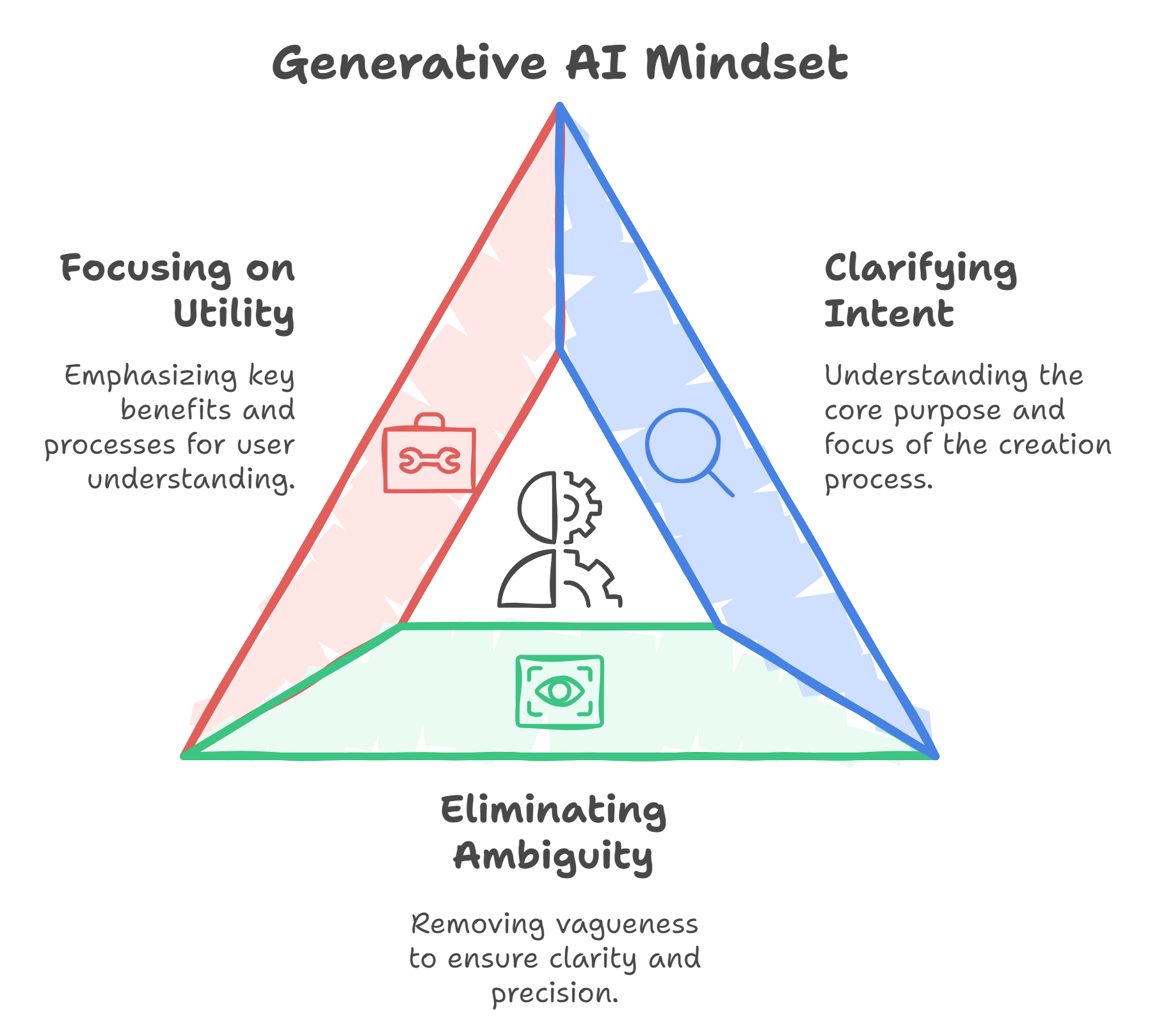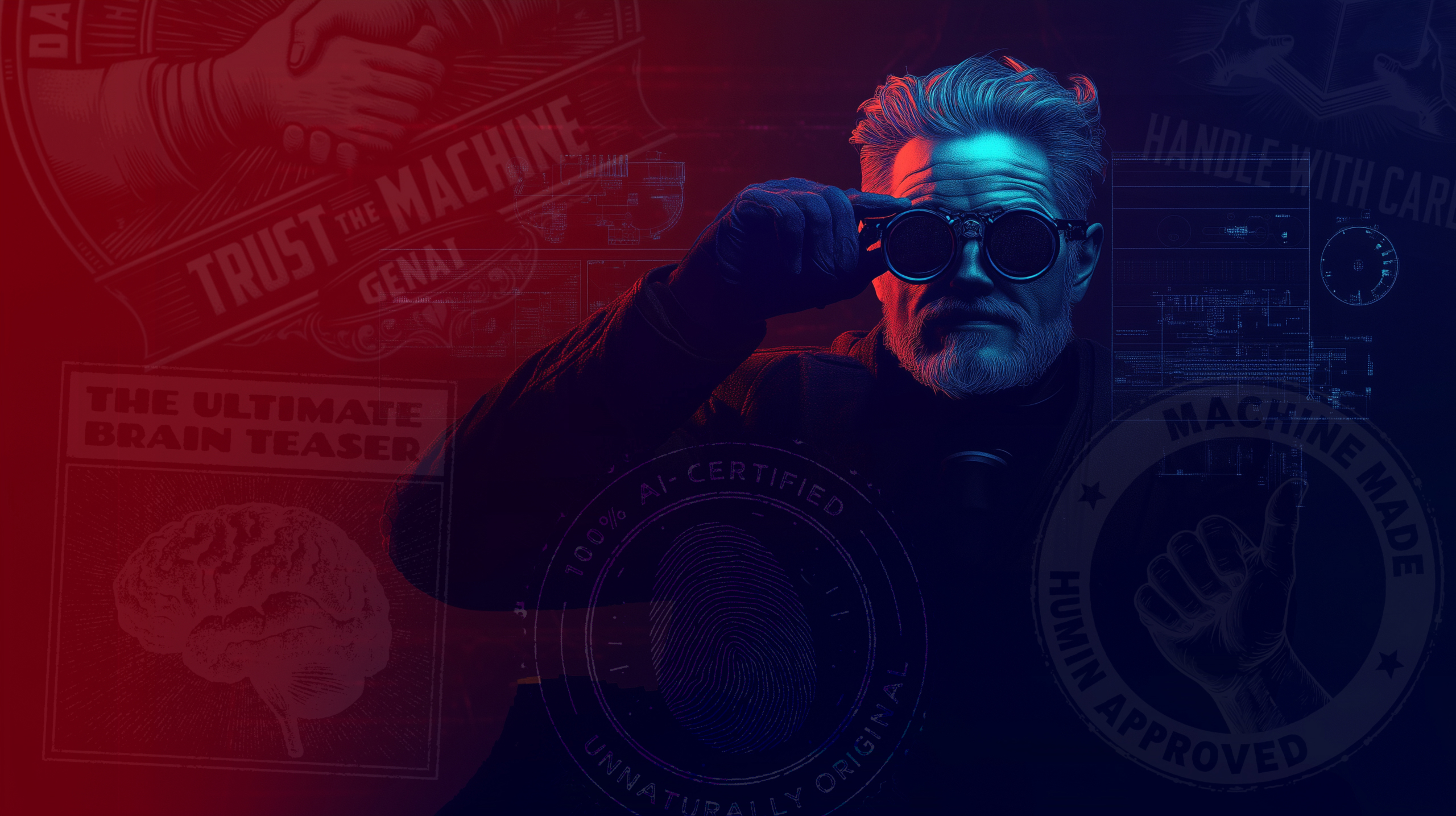Working with GenAI – The real big shift is cognitive

THE DEEP DIVE | Podcast
As I explore the rise of generative AI, I’ve come to realize it’s triggering a cognitive revolution in how I create content. It challenges traditional workflows and demands a complete shift in my approach to creative work—it’s not just about learning new tools, but rethinking my entire mindset.
What we’re witnessing in content creation is a shift happening at the cognitive level—a fundamental change in how we approach the creative process, not merely a new tool or technique. Generative AI is both powerful and disruptive, and it challenges traditional workflows that often require mastery across multiple domains—be it sound engineering, scriptwriting, or UX design.
Instead of needing deep knowledge in every production step, generative AI demands that we condense and articulate the core intent up front. Imagine having to strip a complex idea down to its bare essentials, like reducing a movie to just a logline that tells you everything you need to know. It’s a lot like first principles thinking—breaking down a concept to its most fundamental components and then building it back up.
For example, in a recent project, I had to describe a tool in just three or four sentences—a task that forced me to:
-
- Clarify the intent: What is this tool about? What’s its core purpose? This is about setting the core narrative—defining what ties everything together.
- Eliminate ambiguity: With limited words, there’s no room for vagueness. This involves distinguishing the cause and effect, which is where synthesis skills come in—synthesizing information to see the underlying structure and eliminate confusion.
- Focus on utility: What are the key benefits and processes users need to understand? This is where context comes into play—defining the specific context of usage helps ensure the solution is suitable and effective for its intended purpose.

The AI then took that core insight and turned it into a tangible workflow, visualized and ready to iterate on. It’s a different mental discipline compared to the traditional approach, where creators may get lost in the details of every production step. With generative AI, you keep your focus sharp—on vision and intent—so that the creative energy stays alive, without the burden of executing every technical task yourself.
Workflows, tool mastery, and iterative exploration
To better transition to specific examples of how this cognitive shift manifests, let’s explore how workflows and tool mastery come into play. Using generative AI isn’t about just learning a new tool; it’s about creating a workflow that maximizes each tool’s unique strengths. For example, I use Midjourney and Ideogram for initial image generation, and then Krea and Magnific AI for refining and upscaling. Each tool serves a distinct purpose, and being able to curate a toolkit—knowing when to use which tool and why—is essential for achieving high-quality outcomes. The tools are evolving quickly, and so must we. The real power of AI isn’t in the tools themselves; it’s in your ability to guide them—shaping, refining, and combining different parts into a cohesive, impactful whole.
On iterative explorations; Take my tarot card project, for example. I wanted to create a visually consistent yet individually unique deck. DALL-E 3 had the exact visual style I was after, so even though it was slower compared to Midjourney, I chose it because it matched my vision. Each card had its own unique composition and symbolism, and to achieve this, every text prompt had to be meticulously prepared, tested, and iterated upon. This often meant generating 50-150 images to get each card just right. This project was a classic case of balancing speed versus artistry. Yes, Midjourney would have been faster, but DALL-E 3 provided the specific quality I was looking for. Sometimes, it’s not about how quickly you can finish a project; it’s about staying true to the vision and putting in the time to get it right.
To better illustrate the differences between traditional and generative AI-driven content creation workflows, consider the following visual representation:

-
- Traditional Workflow: A step-by-step, linear process where each phase (research, ideation, setup, creation, refinement, production) happens in sequence, often leading to slow progression and potential loss of creative momentum.
- Generative AI Workflow: A dynamic, iterative approach where initial drafts are quickly generated, followed by continuous exploration, iteration, and refinement, allowing creativity to flourish at every stage.
Example of different traditional vs. AI-supported content workflows :
It’s a 180-degree shift in mindset
Building on these practical workflows, it’s crucial to understand how our entire mindset around creativity needs to adjust to accommodate these new processes. And it’s indeed a 180-degree shift from traditional approaches:
-
- From Process to Outcome: Traditional methods emphasize process—each stage must be perfect before moving on. With AI, you start with an outcome and work backward, refining and improving as you go.
- From Mastery of Steps to Mastery of Intent: Instead of mastering every step of the process, your focus shifts to mastering the clarity of your intent. You must know what you want at a fundamental level, and then guide the AI to help bring that vision to life.
- From Deep Expertise to Broad Creativity: Traditional creative work often demands deep specialization—mastering specific software or techniques. Generative AI, however, democratizes creativity by allowing you to focus on the broader vision. You don’t need to master every tool, but you need to guide the AI effectively—which requires a different kind of creative skill.
Adapting to a new Way-of-Working
Having established the importance of maintaining the core vision, let’s look at how we adapt our cognitive approach and practical methods to fit this new creative paradigm. The biggest challenge with generative AI lies at the cognitive level—changing how we think and how we approach creativity. This shift can feel unsettling, especially for those of us used to traditional workflows that are more linear and detail-heavy. Instead of taking a step-by-step journey, AI encourages an outcome-first approach:
-
- Articulate goals clearly: Generative tools require specific, clear prompts. If you can’t explain your desired outcome concisely, the AI won’t deliver anything useful. This forces us to refine our intent and be really clear about what we want.
- Embrace iteration: Traditional workflows tend to make changes difficult once decisions are locked in at each phase. With AI, it’s all about creating rough versions, evaluating, and refining. It’s about embracing iteration—failing fast and learning fast.
- Be open to unexpected results: AI can surprise you, sometimes generating outputs you hadn’t anticipated. This requires a willingness to adapt, to explore unexpected directions, and to view the AI as a creative partner, not just a tool.
Maintaining objectivity and the core narrative
Once we recognize the shift in mindset, another key aspect is maintaining the integrity of the core idea throughout complex creative projects. One of the biggest challenges in traditional creative processes—especially when working on complex projects like music production or UX design—is maintaining the core narrative, the guiding vision that ties everything together. It’s easy to lose sight of your original idea when you’re switching hats constantly—jumping from producing to mixing, or from designing to coding, each requiring different mental skillsets.
Generative AI helps maintain this objectivity. It keeps your core vision intact while handling some of the execution details. It’s like having a creative assistant who handles the repetitive bits, allowing you to keep your focus on the big picture and on how each piece fits within that larger vision. You can iterate quickly, test variations, and see a version of your outcome much sooner—without getting bogged down in every small decision. AI keeps the core narrative visible, allowing you to refine without losing your place in the creative journey.
Synthesis and context: The creative superpowers
Beyond adapting processes, leveraging synthesis and context becomes vital—these are the superpowers that humans bring to AI-driven creativity. In this new landscape, synthesis and understanding context are emerging as crucial creative skills. It’s not enough to just know how to use tools; you need to connect the dots—to see patterns, to create meaning, and to bring everything together cohesively. Generative AI can generate components, but it’s the human ability to synthesize that adds depth and significance.
In my own work, synthesis often begins with a blank canvas—gathering insights, grouping them, trying out different arrangements until something clicks. Whether it’s visual styles, interview findings, or symbolic concepts, it’s about constantly arranging and rearranging elements until the story makes sense. This is also where context comes in—understanding the context helps determine how each piece should be arranged for maximum impact. Generative AI can offer initial ideas, but it’s the synthesis and contextual understanding that make the real magic happen.
Collaborative creativity: Embracing Generative AI
The essence of generative AI lies in collaboration—where AI augments human creativity rather than replacing it. This partnership allows creatives to shift their focus from repetitive, technical execution to high-level ideation and exploration. By collaborating with AI, we are effectively extending our creative toolkit to include not only traditional tools and techniques but also intelligent systems capable of generating, iterating, and refining content.
This collaboration isn’t a one-way street; it’s about active participation. AI provides the rapid generation of ideas, but it’s our role as creatives to direct, filter, and shape these ideas to meet our vision. The magic lies in how we interact with what the AI generates—by enhancing, reimagining, and synthesizing it into something uniquely human.
Generative AI opens new doors for creativity by offering multiple perspectives at lightning speed, thereby expanding the scope of what’s possible. We can test different styles, experiment with iterations, and refine ideas without the constraint of traditional linear workflows. This approach accelerates the creative process and encourages a more fluid, experimental mindset.
Ultimately, collaborative creativity is about embracing unpredictability. With AI by our side, we have to learn to value the unexpected. The creative journey is no longer strictly under our control, but that unpredictability brings new opportunities for inspiration. The future of creativity is not AI versus human—it’s AI and human working in synergy. Together, we are capable of pushing the boundaries of imagination, innovating in ways that were previously unimaginable.
The future is collaborative: Final thoughts on the Great Shift
This shift isn’t just about new tools—it’s about breaking old habits and adopting a completely new way of thinking. The traditional ways we’ve learned to approach creativity are being upended, and this is both an internal and external journey. For many, finding this new way forward will be challenging, as it requires us to not only learn new tools but also to rewire our brains to adapt to a new reality.
The cognitive shift demands new skill sets—ones that focus less on linear processes and more on intent, adaptability, and AI collaboration. It’s about embracing ambiguity, leaning into iteration, and redefining what it means to create. The new creative toolbox is full of unexpected and evolving tools, but the biggest change lies within our own capacity to think differently, to adapt, and to thrive in a reality where AI plays an active role in creativity.
How this post was made...
This text was created based on a discussion about the creative shift in content creation using generative AI tools. The insights shared here were developed collaboratively through a dialogue, incorporating work-related examples and iterative refinement. The conversation took place between me(Michael Käppi) and with ChatGPT-4o with Canvas, leveraging its canvas feature to explore these topics interactively, resulting in this post that captures both practical and conceptual shifts in creative work.











0 Comments